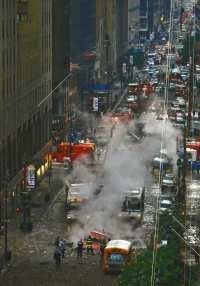
Apartment buildings, whether cooperatives or condos, are inherently fragile. When that many units share the same plot of land, and the same walls, the same floors, the same elevators and stairways, standpipes and boilers, lobbies and roofs, disasters—whether broken water pipes or the tragic in the case of decomposing bodies, fatal fires or building explosions—have the potential to spread quickly. Thus, when something nasty befalls a building, the first order of business is to contain the problem.
Once the situation has been contained, however, then the hard part begins: the cleanup. How do buildings get back on their proverbial feet after a major maintenance meltdown? What should a board or property manager know about dealing with disasters? And is there a way to prevent bad things from happening in the first place? Let's take a look.
Water, Water Everywhere
When contemplating disasters, the first example that comes to mind is usually fire. Fire, after all, can spread quickly and devastate an entire city, and do so in spectacular fashion. Much of Lower Manhattan was burned to the ground by the British in the War of 1812, and, while our ability to prevent and combat fires is far superior to what it was two hundred years ago, fire remains a big fear.
But it's not fire, but the element that puts it out, that causes most of the damage to New York residential buildings.
"Look around, and see how many buildings are burning right now," says Ron Alford, the founder and president of Disaster Masters Inc. in Queens. "None. On the other hand, water damage is going on right now, as we're talking," or as you're reading this.
Water damage can happen in many ways. In the winter, Alford says, if it's nine degrees outside for a few days, and the right combination of doors are left open accidentally, the standpipe—the central conduit for water in the building—can break. In the summer, condensation from air conditioning units can wreak havoc on hardwood floors, especially in apartments that have been vacated for the season.
Leaky pipes can drip into the apartment downstairs, and then the apartment two floors down, and then the one floor below that. And busted standpipes can do much more extensive damage. Remedying this kind of problem can escalate to the total replacement cost of the entire building, says Alford, if the damage is extensive.
Floods of this nature are seldom the result of negligence, Alford says.
"These are not caused by shoddy maintenance," he explains. "Because of the local laws, the buildings are all well-maintained. The things we do tend to be sudden and insured."
Insurance can be its own headache. Insurance companies can send the wrong personnel to handle a problem, or, worse, deny a claim. Getting money from insurance companies can be such a tricky process, in fact, that Alford has a side business that deals solely with getting claims paid by insurance companies, and has authored a book on the subject.
Handling the Unexpected
Property managers have to be adept at dealing with acts of God or natural disasters that you have no preparation or training for. One such scenario involved Donna Ross, the director of management at Andrea Bunis Management Inc. in Manhattan. Ross, a 30-year veteran in property management, has been with Andrea Bunis for the past 15 years. Back in August 1989, she was called to the scene of a Con Edison steam pipe explosion reminiscent of the one that recently shut down blocks around Lexington Avenue and Grand Central Terminal this summer.
The 1989 pipe explosion killed three people, injured 24, and caused evacuation of about 200 residents of the 185-unit cooperative at 32 Gramercy Park South. What the managers and residents did not know then was that the pipe contained asbestos and it would be months before the cleanup and restoration brought things back to normal.
"Saturday night was the explosion and Sunday morning I and other agents were at the site to see what we could do to help the residents of the building," says Ross. "Since we did not know at that time that the building was contaminated with asbestos, we were helping people clean up sweeping the asbestos in the air and our lungs.
"Days after the cleanup started, it was determined that there was asbestos found throughout the building and the DEP [Department of Environmental Protection] evacuated the building. Residents were given very little time to take some belongings and leave. Police were stationed on each of the floors to guard the apartments until the decontamination started. Residents were put up in nearby hotels at first and as time went on, it was determined that this was not going to take a few days. They were then moved to apartment efficiencies or given money to go elsewhere. Management set up trailers near the building so that residents would have access to management to help in their daily needs," Ross explains. Some people were allowed back inside to retrieve belongings or medication, she says, and others to pack things for a much-needed vacation away from the city. "We had no idea that it would be eight months later before all was said and done."
Ross was enlisted to serve as a liaison and coordinate management tasks between different city agencies, including Con Ed, the NYPD, the FDNY, asbestos removal specialists and various contractors. The building had to be decontaminated and completely cleaned, blown-out windows had to be replaced, the water tower had to be cleaned and repaired, and day-to-day questions and concerns taken care of, she adds.
"Residents still needed information about what was happening with their homes. I was answering their questions as to reimbursement for their food, and housing and clothes. The explosion happened in August, and a few seasons had passed, so residents needed different seasons of clothes. Remember most of them left that day in August with what was on their back. Basically, the building was completely cleaned inside and out before residents would be allowed to move back in."
Remains of the Day
Then there is the other potential disaster—the decomposing body. Sometimes there is violence involved—suicides or homicides, for example—but usually, the decomposing body problem occurs when a single, typically elderly person dies, and no one realizes it until the smell trails into the hallway.
"Let's say an elderly person dies of natural causes," says Ron Gospodarski, president of Bio-Recovery Corp. in Long Island City. "New York being transient as it is, usually the kids are elsewhere. It goes undetected for days or weeks until someone smells it and calls 911."
The police then come and seal off the area while they conduct an investigation. "Nobody can go in there," Gospodarski says. "And you have this nasty odor coming out."
The more the body decomposes, the worse the odor gets. "The odor will infiltrate everywhere," says Ron Vogel, president of Emergi-Clean Inc. in Linden, New Jersey.
Meanwhile, the police yield to the public administrator, who is in charge of locating and contacting the next of kin. Once it is determined that the death was not a homicide, the body is taken away. But some of the remains remain—and those remains reek. Until the police or the public administrator grants access to the apartment, there isn't much the board can do about it.
"Sometimes we'll go with" the public administrator, says Gospodarski. "But most of the time, they don't let us in."
This can be extremely unpleasant—and dangerous.
In one case, Gospodarski says the liquefied remains had eaten through the hardwood floors—it was a brownstone, so there was no concrete between the floors.
"Bodily fluids were dripping into the apartment below, where there was a newborn baby," he recalls.
This is, needless to say, not the most healthful situation.
Cleaning up human remains is not generally something that's covered at board meetings. Many property managers are probably at a loss as to what exactly the next step should be. There is no subheading for this kind of thing in the Yellow Pages—and that's not the most effective disaster preparedness anyway.
"The worst thing you can do is use a phone directory for a disaster," Alford says.
Many boards or property managers will ask the super to handle the mess. Not only does this put the health of the super at risk, and subject the building to major liability, it's also illegal.
"Supers are often forced to do it, which is illegal," says Gospodarski. "Who can clean it up legally? Fifty percent are cleaned up by managers or supers. Is that legal? No."
To legally handle human remains, one requires yearly shots for hepatitis B, as well as special training and certification from the Occupational Safety & Health Administration (OSHA) and the Department of Environmental Protection or Conservation, which is prohibitively expensive for most buildings.
"The cost would be unbelievable," says Vogel. The total cost to meet all of the requirements would be in the thousands of dollars for each individual certified, he says.
Then there's the matter of disposal. Let's say someone dies in bed, and bodily wastes infiltrate the mattress.
"Where do they dispose of it? You can't put it in the sanitation system," says Gospodarski. "It has to go by red bag. You have to be licensed to pick it up."
This doesn't stop bloody mattresses from finding their way into the regular trash, of course. This is New York, after all. But that is illegal, too.
Finally, there's the bottom line. Who pays for the mess? The estate of the deceased? The co-op, because the liquefied remains oozed between floors? The deceased's insurance company? The co-op's insurance company? Often, the co-op ends up with the tab - and a cleanup of this sort can cost anywhere from $450-$2,000.
"They say, 'Let's pay to get it fixed first,' and then they'll worry," Vogel says.
"Often, the management company will pay, and then get the money from the board," says Gospodarski.
What should a building do to prepare for such a catastrophe?
"You need to know who to call," says Alford. Managers and boards should have an emergency or restoration company in mind before a disaster strikes.
Some companies even offer "pre-disaster audits," where teams would inspect the premises for potential problems.
What It Teaches You
Surviving an emergency takes patience and understanding, Ross says.
"As a property manager, the job itself teaches you to juggle many things at once so that you are able to accomplish your goal—add a lot of patience and consideration to the mix and you can survive a crisis like this one or this job in general."
Residents need to trust the board, management and the hired professionals to maintain the public safety and health and well-being of the residents they're entrusted to care for.
"In order to be an effective property manager you need to wear many hats," says Ross. "You need to be able to be calm under pressure, caring and considerate, understanding that you're dealing with people's homes, a very sensitive subject. In an agent's day, very few people are calling to thank you for something you may have done, most calls are complaints. You need to take the call, solve the problem and move on," she says, adding that you need to also manage the stress that comes with the job.
Greg Olear is a freelance writer, editor, web designer, astrologer and stay-at-home dad living in Highland, New York.






Leave a Comment